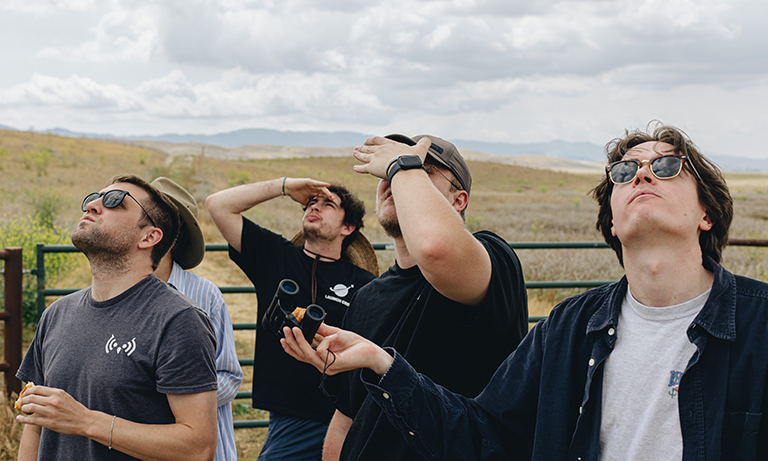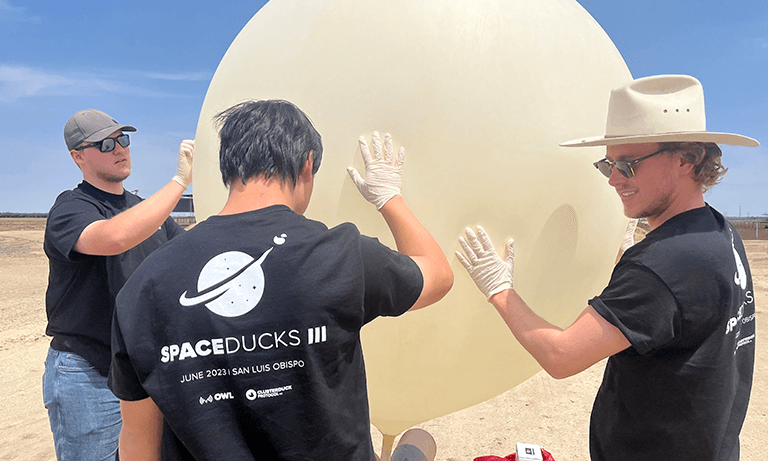In traditional Learn by Doing fashion, 14 Cal Poly engineering students and faculty members Steve Dunton and Dennis Derickson are working closely with a startup company to build low-cost long range (LORA) radio mesh networks and, eventually, deploy the LORA link into space.
Startup OWL Integrations’ team has been working alongside Cal Poly students and faculty members since 2019. The hardware and software company provides communications during natural disasters, tactical missions and space exploration through low-cost radio mesh networks, affectionately nicknamed “Ducks.” These mesh networks utilized the “Cluster Duck Protocol (CDP)” that was created by OWL integrations and their open-source hardware and software partners. The CDP allows for communications in remote locations where infrastructure is lacking or has been destroyed.
Cal Poly is helping OWL expand the applications of LORA networks by making a customized solution that will be launched in partnership with the cube-sat program at Cal Poly.
“The partnership with Cal Poly and OWL Integrations began with Evan Agarwal (Aerospace Engineering, ‘21), who was in the Weather Balloon Society,” said the project’s principal investigator Steve Dunton, who teaches electrical engineering and aerospace engineering at Cal Poly.
“One of the company’s founders, Bryan Knouse, was intrigued by flying high-altitude balloons and the opportunity for him to put his radios on balloons.”
Cal Poly and OWL Integrations were recently awarded more than $1 million in joint research funding from the Air Force Research Labs Phase II Small Business Technology Transfer Program to further expand the radio networks.
“This funding enables OWL and Cal Poly to grow an already thriving partnership,” said OWL Integrations co-founder and CEO Bryan Knouse. “OWL is very lucky to have such a capable partner with a rich history in aerospace and spacecraft development. At the same time, OWL is unyielding in its commitment to ensure that we provide students and the research community with impactful work opportunities on projects with real commercial application.”
In 2019, six hurricanes hit the East Coast, wiping out communications infrastructure.
“The cellphone towers were down; everything was down,” Dunton recalled. “The team who started OWL came up with this concept of these low-cost radios that could interconnect to each other and form mesh networks.”
The networks successfully improved communication efforts throughout the affected areas.
With aid from Cal Poly students, OWL Integrations has also branched out to create sensors that collect data for environmental monitoring.
“We have students who are working on interconnecting methane sensors since methane leaks are a big deal,” Dunton said. “One of the biggest problems with methane is just detecting the leaks.”

Electrical engineering graduate student Kevin Nottberg first got his hands on one of OWL’s projects during his capstone while he was pursuing an undergraduate degree in computer engineering.
Nottberg and his peers built a custom electronics board for the startup and, fitting the duck-related theme, named it the “Quacker Board.”
“We have a lot of puns here,” Nottberg said with a grin.
The Quacker Board has since evolved into an improved version called the “Quacker Advanced Development Board,” or QUAD.
“The goal is to improve the electronics platforms that underpin the entire communication system that OWL runs,” he said.
Cal Poly students continue to play a crucial role in the success of OWL Integrations’ projects.
“Oftentimes, industry plans that students are asked to work on are side projects that are useful to the corporation but not essential,” said Dennis Derickson, electrical engineering professor and the project’s faculty adviser. “What we are doing with OWL is not a small part, but a critical part of the company.”
“That raises the stakes,” Nottberg said. “It makes the project really intriguing and exciting to work on.”
Within the next year, OWL Integrations and Cal Poly are planning to send a Duck into space.
“We have an opportunity to piggyback on a CubeSat,” Dunton said.
CubeSats are a class of nanosatellites and were originally developed in 1999 by Cal Poly and Stanford University to provide a platform for education and space exploration.
The Cal Poly CubeSat Laboratory is a student-run, multiciliary independent research lab that allows students to perform experiments and launches.
“We also have a plan to fly on the International Space Station, but that will be more expensive,” Dunton explained. “We want to be ready for it in this phase, but maybe it will happen in the next phase.”
By Taylor Villanueva


